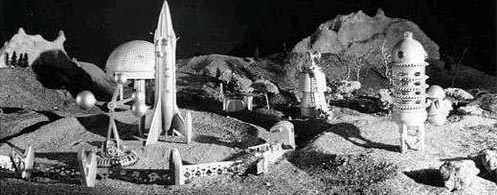


|

|
| Leo Russell, Alex Haberstroh and Harry Persanis filming Captain Video special effects. | Harry Persanis and Leo Russell filming Captain Video special effects. |

|
| Another look at the fabulous CAPTAIN VIDEO miniature sets and models of Russell, Haberstroh and Persanis. We recall that the Video Rangers had a spaceport in an isolated mountainous region of earth, and another on an asteroid. We suspect this set served for both; note the terrestrial pine trees on the left edge of the set, and the wild "alien" vegetation on the right edge. Choosing the proper camera angle would switch from earth to asteroids! |
| James Caddigan | Michael and Kit Menkin | Charles Polacheck | Irving Robbin | Frankie Thomas | Main Page |
|---|
